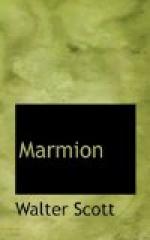line 121. The English archers under the Tudors were famous. Holinshed specially mentions that at the battle of Blackheath, in 1496, Dartford bridge was defended by archers ’whose arrows were in length a full cloth yard.’
Stanza ix. line 130. morion (Sp. morra, the crown of the head), a kind of helmet without a visor, frequently surmounted with a crest, introduced into England about the beginning of the sixteenth century.
line 134. linstock (lont, a match, and stok, a stick), ’a gunner’s forked staff to hold a match of lint dipped in saltpetre.’
yare, ready; common as a nautical term. Cp. Tempest, i. I. 6, ‘Cheerly, my hearts! Yare, yare!’ and see note to Clarendon Press edition of the play.
Stanza X. line 146. The angel was a gold coin struck in France in 1340, and introduced into England by Edward iv, 1465. It varied in value from 6s. 8d, to 10s. The last struck in England were in the reign of Charles I. The name was due to the fact that on one side of the coin was a representation of the Archangel Michael and the dragon (Rev. xii. 7). Used again, St. xxv. below.
line 149. brook (A. S. brucan, to use, eat, enjoy, bear, discharge, fulfil), to use, handle, manage. Cp. Chaucer, ‘Nonnes Prestes Tale,’ line 479,—
‘So mote I BROUKEN wel min eyen twey,’
and ‘Lady of the Lake,’ I. xxviii—
’Whose stalwart
arm might brook to wield
A blade like this
in battle-field. ’
For other meaning of the word see xiii. and xvi. below.
Stanza xi. line 151. Pursuivants, attendants on the heralds, their tabard being a sleeveless coat. Chaucer applies the name to the loose frock of the ploughman (Prologue, 541). See Clarendon Press ed. of Chaucer’s Prologue, &c.
line 152. scutcheon = escutcheon, shield.
line 156. ’Lord Marmion, the principal character of the present romance, is entirely a fictitious personage. In earlier times, indeed, the family of Marmion, Lords of Fontenay, in Normandy, was highly distinguished. Robert de Marmion, Lord of Fontenay, a distinguished follower of the Conqueror, obtained a grant of the castle and town of Tamworth, and also of the manor of Scrivelby, in Lincolnshire. One, or both, of these noble possessions was held by the honourable service of being the royal champion, as the ancestors of Marmion had formerly been to the Dukes of Normandy. But after the castle and demesne of Tamworth had passed through four successive barons from Robert, the family became extinct in the person of Philip de Marmion, who died in 20th Edward I without issue male. He was succeeded in his castle of Tamworth by Alexander de Freville, who married Mazera, his grand-daughter. Baldwin de Freville, Alexander’s descendant, in the reign of Richard I, by the supposed tenure of his castle of Tamworth, claimed the office of royal champion, and to do the service appertaining;




